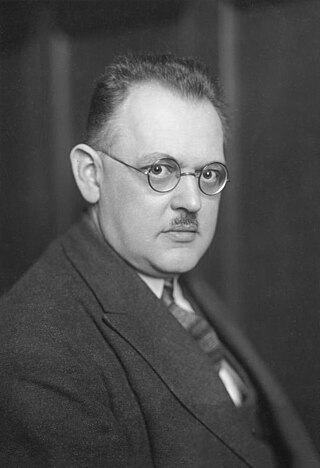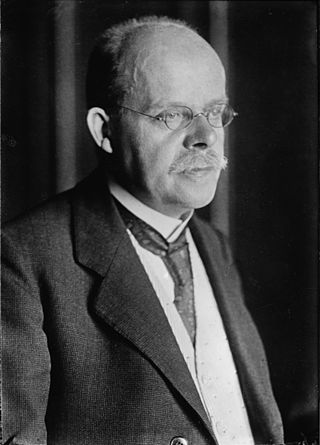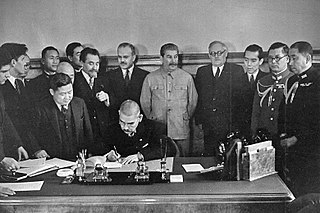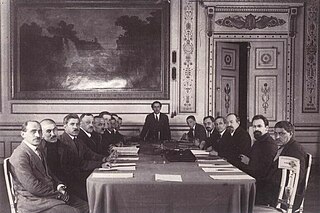Related Research Articles

Gustav Ernst Stresemann was a German statesman who served as chancellor of Germany from August to November 1923, and as foreign minister from 1923 to 1929. His most notable achievement was the reconciliation between Germany and France, for which he and French Prime Minister Aristide Briand received the Nobel Peace Prize in 1926. During a period of political instability and fragile, short-lived governments, Stresemann was the most influential politician in most of the Weimar Republic's existence.

The Treaty of Rapallo was an agreement signed on 16 April 1922 between the German Reich and Soviet Russia under which both renounced all territorial and financial claims against each other and opened friendly diplomatic relations. The treaty was negotiated by Russian Foreign Minister Georgi Chicherin and German Foreign Minister Walther Rathenau. It was a major victory for Russia especially and also Germany, and a major disappointment to France and the United Kingdom. The term "spirit of Rapallo" was used for an improvement in friendly relations between Germany and Russia.

The Locarno Treaties were seven agreements negotiated in Locarno, Switzerland, from 5 to 16 October 1925 and formally signed in London on 1 December, in which the First World War Western European Allied powers and the new states of Central and Eastern Europe sought to secure the post-war territorial settlement, in return for normalizing relations with the defeated German Reich. It also stated that Germany would never go to war with the other countries. Locarno divided borders in Europe into two categories: western, which were guaranteed by the Locarno Treaties, and eastern borders of Germany with Poland, which were open for revision.

Hermann Müller was a German Social Democratic politician who served as foreign minister (1919–1920) and was twice chancellor of Germany during the Weimar Republic. In his capacity as foreign minister, he was one of the German signatories of the Treaty of Versailles.

The Little Entente was an alliance formed in 1920 and 1921 by Czechoslovakia, Romania and the Kingdom of Serbs, Croats and Slovenes with the purpose of common defense against Hungarian revisionism and the prospect of a Habsburg restoration in Austria or Hungary. France supported the alliance by signing treaties with each member country. The rapid growth of German power caused its collapse in 1938, and it never went into wartime operation.

Wilhelm Marx was a German judge, politician and member of the Catholic Centre Party. During the Weimar Republic he was the chancellor of Germany twice, from 1923–1925 and 1926–1928, and served briefly as the minister president of Prussia in 1925. With a total of 3 years and 73 days, he was the longest-serving chancellor during the Weimar Republic.

The Soviet–Japanese Neutrality Pact, also known as the Japanese–Soviet Non-aggression Pact, was a non-aggression pact between the Soviet Union and the Empire of Japan signed on April 13, 1941, two years after the conclusion of the Soviet-Japanese Border War. The agreement meant that for most of World War II, the two nations fought against each other's allies but not against each other. In 1945, late in the war, the Soviets scrapped the pact and joined the Allied campaign against Japan.

Ulrich Karl Christian Graf von Brockdorff-Rantzau was a German diplomat who became the first Foreign Minister of the Weimar Republic. In that capacity, he led the German delegation at the Paris Peace Conference but resigned over the signing of the Treaty of Versailles. He was also the German ambassador to the Soviet Union from 1922 to 1928.

German–Soviet Union relations date to the aftermath of the First World War. The Treaty of Brest-Litovsk, dictated by Germany ended hostilities between Russia and Germany; it was signed on March 3, 1918. A few months later, the German ambassador to Moscow, Wilhelm von Mirbach, was shot dead by Russian Left Socialist-Revolutionaries in an attempt to incite a new war between Russia and Germany. The entire Soviet embassy under Adolph Joffe was deported from Germany on November 6, 1918, for their active support of the German Revolution. Karl Radek also illegally supported communist subversive activities in Weimar Germany in 1919.
The Timeline of the Weimar Republic lists in chronological order the major events of the Weimar Republic, beginning with the final month of the German Empire and ending with the Nazi Enabling Act of 1933 that concentrated all power in the hands of Adolf Hitler. A second chronological section lists important cultural, scientific and commercial events during the Weimar era.

This timeline of events preceding World War II covers the events that affected or led to World War II.

The Treaty of Moscow, or Treaty of Brotherhood was an agreement between the Grand National Assembly of Turkey (TBMM), under the leadership of Mustafa Kemal, and Russia, under the leadership of Vladimir Lenin, signed on 16 March 1921. Neither the Republic of Turkey nor the Soviet Union had then been established. The internationally recognised Turkish government at the time was that of Sultan Mehmed VI, but it was not party to the Treaty of Moscow. The Sultan's government had signed the Treaty of Sèvres, which had been repudiated by the Turkish National Movement.

The remilitarisation of the Rhineland began on 7 March 1936, when military forces of the German Reich entered the Rhineland, which directly contravened the Treaty of Versailles and the Locarno Treaties. Neither France nor Britain was prepared for a military response, so they did not act. After 1939, commentators often said that a strong military move in 1936 might have ruined the expansionist plans of Adolf Hitler, the dictator of Germany. However, recent historiography agrees that both public and elite opinion in Britain and France strongly opposed a military intervention, and neither had an army prepared to move in.
The Franco-Soviet Treaty of Mutual Assistance was a bilateral treaty between France and the Soviet Union with the aim of enveloping Nazi Germany in 1935 to reduce the threat from Central Europe. It was pursued by Maxim Litvinov, the Soviet foreign minister, and Louis Barthou, the French foreign minister, who was assassinated in October 1934, before negotiations had been finished.

Relevant events began regarding the Baltic states and the Soviet Union when, following Bolshevist Russia's conflict with the Baltic states—Lithuania, Latvia and Estonia—several peace treaties were signed with Russia and its successor, the Soviet Union. In the late 1920s and early 1930s, the Soviet Union and all three Baltic States further signed non-aggression treaties. The Soviet Union also confirmed that it would adhere to the Kellogg–Briand Pact with regard to its neighbors, including Estonia and Latvia, and entered into a convention defining "aggression" that included all three Baltic countries.
The timeline of the Molotov–Ribbentrop Pact is a chronology of events, including Molotov–Ribbentrop Pact negotiations, leading up to, culminating in, and resulting from the Molotov–Ribbentrop Pact. The Treaty of Non-aggression between Nazi Germany and the Soviet Union was signed in the early hours of 24 August 1939, but was dated 23 August.

The background of the occupation of the Baltic states covers the period before the first Soviet occupation on 14 June 1940, stretching from independence in 1918 to the Soviet ultimatums in 1939–1940. Lithuania, Latvia, and Estonia gained independence in the aftermath of the Russian revolutions of 1917 and the German occupation which in the Baltic countries lasted until the end of World War I in November 1918. All three countries signed non-aggression treaties with the Soviet Union in the 1920s and 1930s. Despite the treaties, in the aftermath of the 1939 German–Soviet pact, Estonia, Latvia and Lithuania were occupied, and thereafter forcibly incorporated into the Soviet Union, in 1940.

Soviet Union–Turkey relations were the diplomatic relations between the Soviet Union and the Republic of Turkey.

The first Luther cabinet, headed by the political independent Hans Luther, was the 12th democratically elected government of the Weimar Republic. It took office on 15 January 1925, replacing the second cabinet of Wilhelm Marx, which had resigned when Marx was unable to form a new coalition following the December 1924 Reichstag election. Luther's cabinet was made up of a loose coalition of five parties ranging from the German Democratic Party (DDP) on the left to the German National People's Party (DNVP) on the right.
The Treaty of Berlin of August 27, 1918 was an agreement signed after several months of negotiations between Bolshevik representatives and the Central Powers, mainly represented by the Germans. This treaty completed and clarified the political and economic clauses of the Treaty of Brest-Litovsk, which had been left out of the winter 1917-1918 negotiations. The latter were aimed at ending the war between the Central Powers and Russia and clarifying the extent of Russia's territorial losses, but left unresolved the question of war indemnities due to the Imperial Reich and its allies. Similarly, the nature of the new economic relations between the Central Powers and Russia was not discussed in depth at Brest-Litovsk. Consequently, in accordance with the terms of the peace treaty signed in early 1918, negotiations should regulate future economic relations between the Central Powers and Bolshevik Russia, and lead to the conclusion of an agreement between the Reich and its allies, on the one hand, and Russia, on the other. However, due to the rapid development of the conflict during September and October 1918, the provisions contained in the text of this treaty never came into force. Nevertheless, this agreement laid the foundations for the Treaty of Rapallo between the Reich and Bolshevik Russia, which came into force in 1922.
References
- ↑ Crozier 1997: 67
- ↑ League of Nations Treaty Series, vol. 53, pp. 388–396.
- ↑ Tucker 1992: 227
- ↑ Moss 2005: 284
- ↑ League of Nations Treaty Series, vol. 157, pp. 384–391.
- ↑ German-Soviet relations between the two World Wars, 1919–1939: Edward Hallett Carr Ayer Publishing
- ↑ The Avalon Project, Treaty of Berlin Between the Soviet Union and Germany; April 24, 1926 (Complete). Lillian Goldman Law Library.
- ↑ German–Soviet relations between the two World Wars, 1919–1939: Edward Hallett Carr Ayer Publishing p. 91
- ↑ Документы внешней политики СССР Том 14. 1 января – 31 декабря 1931 г. – М.: Политиздат, 1968.